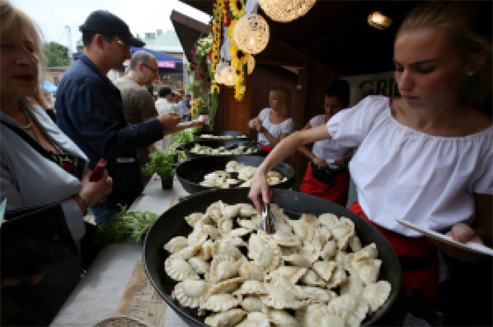The sentiment and effort
A list of arguments “for” can start with the typical reaction of Canadian friends. When it comes to the safe topic of food (they don’t talk about politics) several statements are made, about Polish ancestors and grandma’s culinary masterpieces, and about Polish shops and their wide range of products.
Testing of the market may look like in the case of Gale, who looked to the Polish Press Agency correspondent for tea and croissants with delicacies. Gale, who cooks fantastically, summed up “My grandma was baking the same croissants, and she came from Poland.”
Therefore, these are the tastes of childhood. The majority of those who admit their family connections with Poland while trying Polish dishes do not have time for kneading the dough or boiling the cabbage for cabbage rolls, not to mention cooking the bigos. This last dish anyway, carries an extra risk; as Peter, from a Polish-British-German family admitted, “The neighbours start suspecting that a skunk has moved in somewhere under my terrace. But I like bigos.”.
Poles obviously come back to the tastes of childhood. Restaurants and shops in which there is a delicatessen section can always count on them. Their offer is dominated by fried fish in bread crumbs, schnitzels, fried beets, lazy dumplings, cabbage, potato pancakes, and if you search well you can find mizeria (cucumber salad). Obviously, there are also dumplings, including Russian dumplings. Canadians do not know a typical filling made from potatoes and white cheese – for them there is a version with cheddar.
Fast food in the slow version
As in the whole Western world, Canadians have a problem with fast foods. They do not talk about slow food as much as Europeans do, however, they appreciate dishes prepared without haste, and without enhancements.
Francois and Denise live near Hamilton. Francois was born in Italy and doesn’t appreciate American food. They are very satisfied that a Polish bakery is near their home. They are amazed by the fact that the bread is made from flour, water and sourdough, that it doesn’t contain “things which grandma couldn’t recognise” – as Denise says.
Anyway, dishes which require much effort can be sold like trendy sushi – nicely packed and not complicated to eat. Several years ago on St. Lawrence Market, in the centre of Toronto, there appeared a small stall run by an Ukrainian couple, who were eager to talk in Polish. Over time the outlet has expanded, and not only Poles and Ukrainians visit it in order to buy homemade pastries, cabbage rolls and potato pancakes. St. Lawrence Market is a very trendy tourist place. At the weekends it is visited by those searching among the stalls with food from all over the world. Polish-Ukrainian cuisine, as the experiences of the Ukrainian couple show, fits well into the trend.
Those who have already tasted Polish cuisine are also a good source of word of mouth advertising. Christine, who works in the administration of communal homes in Toronto, returns to, as she says, the best restaurant serving dumplings, namely “Amber”, in Bloor West Village, a trendy part of the Bloor Street in Toronto’s West End. Bloor West Village is not a Polish district, although many Poles live there.
A review of Polish cuisine – excluding dumplings – which have become a hit with the Canadian taste, leads to an amazing finding: cabbage rolls. They can be found in Polish shops in Bloor West Village and in Mississauga, a multicultural city west of Toronto, and on a trendy St. Lawrence Market. Cabbage rolls have not had such a stunning career as potato pancakes or “pierogi” (dumplings) so far, but they are bravely supported by unexpected allies. For instance, near Baby Point, the second region of Toronto, cabbage rolls are on the menu at the French “Ma Maison” restaurant. The owner and chef is a Frenchman who has been living in Canada for 35 years, and serves in his French cuisine shop-restaurant cabbage rolls alongside boeuf bourguignon or guiche lorraine.
It appears that cabbage rolls, which nobody wants to prepare, are the next, little exploited opportunity for Polish cuisine. Such isfast food prepared slowly.
A taste to discover
Creating a business plan including only Polish clients does not really make sense at this point. So bigger shops run by Polish owners search for clients who seek a wealth of tastes.
David, a massage specialist, came to a Polish supermarket seeking pickled food recommended by his doctor, and which is also recommended by dieticians as a natural supplement of the gut flora. This supermarket is a “Starsky” in Mississauga. As he says – he went out from there with heavy bags in which were not only pickled cucumbers and cabbage, but also fresh vegetables. David explains that the wide range of choice and prices lower than in “better” supermarkets encouraged him to do so.
Naoko, a Japanese woman living in Toronto, went to a Polish supermarket searching for a herbal ointment for contusions, which was recommended to her (in Polish shops there can also be found herbal teas, treatment specifics and Polish cosmetics). She stood in admiration before long shelves with candies but she made her way to the stand with cheeses. As a result of her curiosity, she bought several Polish yellow cheeses, including smoked ones. She says that next time, with her English husband, they went out laden with goods because “it is tasty and has only little or no additives at all.”
Barb, a Canadian, looks into Polish shops searching for honeys which are not offered by Canadian companies, for instance mixed honey with propolis and honeydew. She states with admiration that there is no rape honey in Canada, although rape is cultivated on a large scale in this country. Peter in turn, of Greek origin, seeks candies which are unknown to Canadian producers, such as plums in chocolate.
Canadians are open to trying new tastes, perhaps because of the variety of their origins. It appears that not everything has to be as sweet as North American producers’ candies, and that cold cuts by Polish recipes may compete with hamburgers, while Polish cheeses complement French ones.
Among those who are interested in Polish cuisine, there are representatives of nations which have wealthy culinary traditions. Chinese, who work in the neighbouring restaurant Mandarin (this is a chain in which people are offered an international buffet, with a huge Chinese part, for one payment), constantly look into the Polish restaurant in Mississauga. The ladies from Cafe Prego, when asked about Chinese culinary choices, explain that they don’t order dinners very often but they like to come there for coffee and biscuits.
With such a wealth of Polish goods, and dishes which are doing well on the demanding Canadian market, it is truly amazing that nobody has yet tried to create trendy Polish restaurants that should be visited. Even on Roncesvalles, a Polish street in Toronto, there are a Cuban restaurant and two Thai among the trendy outlets. It is hard not to recall an old joke, in which a representative of a shoe factory, who has been sent to Africa, telegraphs: “It makes no sense, everyone walks barefoot.” A second representative telegraphs happily: “A big market, everyone walks barefoot.”
A free trade agreement between Canada and the European Union awaits ratification. In comparison to the American market, Canadian is not big, with only 35 million inhabitants. Nevertheless, – as Canadians and Poles who know Canada say – there are not many people who understand that Canada is a perfect beach head to enter the American market.
From Toronto Anna Lach / Polish Press Agency
Photo © Stanisław Rozpędzik



